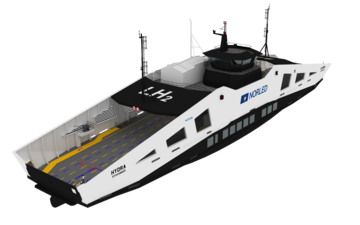- Home REN
- Hem
-
Shop
- Branscher
- Processer
-
Gaser och utrustning
- A-Ö Handla gas från Linde
- Bulkgaser
- Centrala gassystem
- Design och konstruktion
- Fordonsgas och biogas
- Förpackade kemikalier
- Gasdetektorer
- Gaser och kemikalier för elektronik
- Gasinstallationer
- Gasol
- EVOS ViPR
- Gasskolan
- GENIE gasflaska
- Helium
- HiQ specialgaser och specialgasutrustning
- Konsumentprodukter
-
Tjänster
-
Säkerhet
-
Kundservice
-
Nyheter & Media
- Försäljningsställen
Ivan Østvik: ‘Hydrogen will become a low-cost energy source and zero-emission fuel’
Ivan Østvik, Project Manager, Norled AS, is a naval architect by profession who’s worked with ship design, marine technology, and offshore wind for more than 25 years. Since 2015, he has been developing “green” ship projects in Norway, focusing on implementing sustainable and reliable zero-emission energy technologies. He is an internationally recognized expert in maritime zero-emission solutions and has been instrumental in constructing the world’s first liquid hydrogen-powered ship.
What is your role with this hydrogen-fuelled ferry?
I was part of the tendering team and the technology development from day one with colleagues from Norled. So, I've been part of the team designing the ferry, as well as the hydrogen system since the start. And now I’m responsible for building the ferry at Norled, as well as getting the hydrogen system aboard the ferry approved where we are utilising the alternative risk-based design approach in order to ensure a safe operation of the ferry.
What are some of the challenges involved in deploying fuel cell technology at scale?
Well, as I said, one of the main issues is getting the hydrogen system approved. Fuel cell technologies using hydrogen or the liquid hydrogen storage system have never been used on a ship at this scale before. So, one of the main challenges is that there is really no regulatory framework to use as a reference. We need to prove that using the fuel cells running on hydrogen will be just as safe as a diesel driven ferry. We need to do a lot of first principal analysis of everything related to our work with Linde for the storage system and with Ballard for the fuel cells.
How will this project help Norled to reach its vision of running zero-emission vehicles by 2030?
That it’s a success! If we have a successful first project we'll be well on our way to achieving that vision. One of the main issues we face is the lack of hydrogen production in Norway. But we’re very hopeful that there will be distributed, affordable hydrogen production along the Norwegian coast towards 2030 close to where our car ferries and high-speed passenger vessels are operating.
How can hydrogen help decarbonize the broader transport industry?
Hydrogen is flexible. It can come from electrolysis, using renewable power, or it can come from natural gas with carbon capture. Hydrogen can come in the form of compressed or liquid hydrogen or stored as ammonia or other organic compounds.
I’d say hydrogen-powered vessels have a good chance of eliminating diesel-driven ferries and LNG-driven ferries before 2030. And the wider transportation industry will also see huge changes on the back of this. Obviously, we need zero-emission hydrogen production to be scaled up massively. But renewables are getting cheaper all the time. Hydrogen will be a low-cost energy source and a zero-emission fuel that will benefit society as a whole.
If you had one hydrogen-related message for the general public, what would it be?
From Norled's side I would say that we are working to prove that hydrogen ships will be safe to operate as well as technically and operationally viable to use. These aspects will be shown for the first ferry, Hydra, that we are building and soon to be in operation. That's our key message.
Back to start-page of 'Hydrogen: a potential game-changer' deep-dive.

